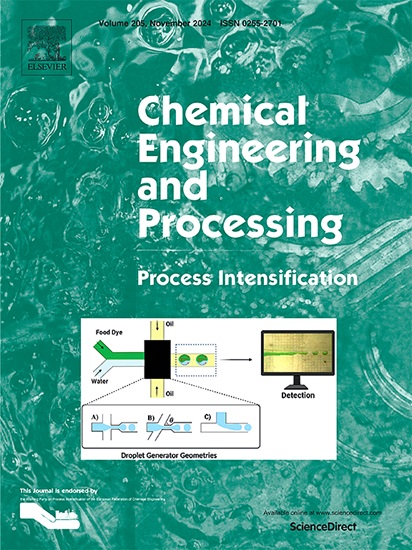Numerical and experimental assessment of separator vessel filter pore size in supercritical CO2 extraction of coriander seed essential oil
IF 3.8
3区 工程技术
Q3 ENERGY & FUELS
Chemical Engineering and Processing - Process Intensification
Pub Date : 2025-03-04
DOI:10.1016/j.cep.2025.110257
引用次数: 0
Abstract
This study investigates the extraction yield of three key compounds of coriander seeds (Linalool, Geranyl acetate, and α-pinene) under exposure to filters having different pore sizes. The experimental design, conducted in a supercritical CO2 extraction apparatus to evaluate coriander essential oil quality, aimed to validate the simulation of the extraction process based on computational fluid dynamics principles. Polyether-sulfone membranes (pore sizes of 0.1, 0.2, and 0.3 µm) were placed in the separator vessel of the supercritical extraction device to monitor the performance of the extract’s key components under the recommended optimum conditions of 200 bar and 35 °C. Prior to experimental testing, numerical analysis successfully simulated the optimum extraction conditions with supercritical CO2, offering insight into how and under what conditions the membranes function optimally. Statistical analysis determined that the 0.3 µm was the optimal membrane pore size for extracting the main compounds of coriander (Linalool, Geranyl acetate, and α-pinene) resulting in a substantial increase in Linalool compared to the Hydro-distillation method (31.89 %). It is concluded that a membrane with the appropriate pore size can positively affect the quantity of the extracted compounds. These findings provide a scientific understanding of the numerical behavior of components and can aid in making informed decisions for various aspects of food engineering processes.

求助全文
约1分钟内获得全文
求助全文
来源期刊
CiteScore
7.80
自引率
9.30%
发文量
408
审稿时长
49 days
期刊介绍:
Chemical Engineering and Processing: Process Intensification is intended for practicing researchers in industry and academia, working in the field of Process Engineering and related to the subject of Process Intensification.Articles published in the Journal demonstrate how novel discoveries, developments and theories in the field of Process Engineering and in particular Process Intensification may be used for analysis and design of innovative equipment and processing methods with substantially improved sustainability, efficiency and environmental performance.

 求助内容:
求助内容: 应助结果提醒方式:
应助结果提醒方式:


